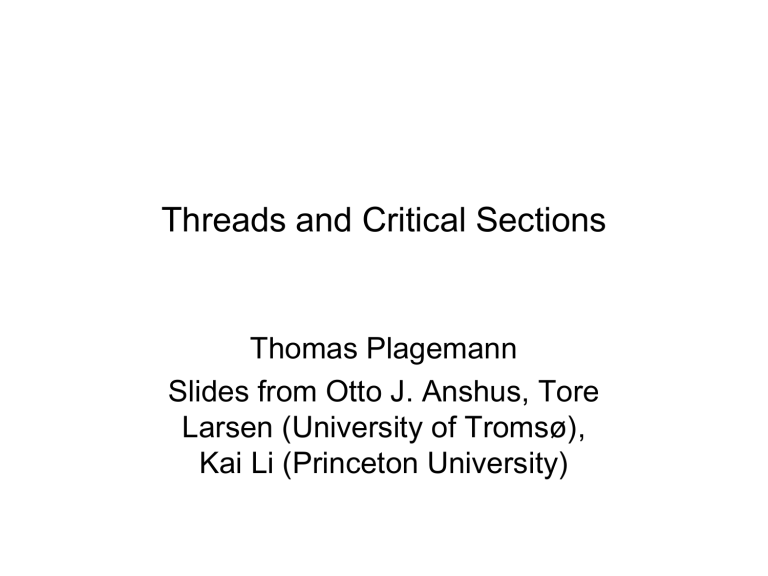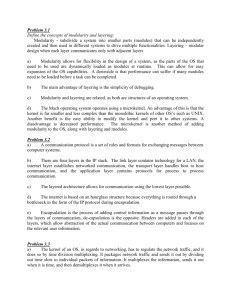
Threads and Critical Sections
Thomas Plagemann
Slides from Otto J. Anshus, Tore
Larsen (University of Tromsø),
Kai Li (Princeton University)
Overview
•
•
•
•
•
Intro to threads
Concurrency
Race conditions & critical regions
Too much milk problem
-> mutual exclusion …..
Thread and Address Space
• Thread
– A sequential execution stream within a process
(also called lightweight process)
• Address space
– All the state needed to run a program
– Provide illusion that program is running on its own
machine (protection)
– There can be more than one thread per address
space
Typical Thread API
• Creation
– Fork, Join
• Mutual exclusion
– Acquire (lock), Release (unlock)
• Condition variables
– Wait, Signal, Broadcast
• Alert
– Alert, AlertWait, TestAlert
•Difficult to use
•Not good: Combines
specification of
concurrency (Fork)
with synchronization
(Join)
Fork/Join
Executes concurrently
P1:
T1:
….
….
FORK T1;
….
END;
….
JOIN T1;
P1 must
WAIT
until T1
finishes
T1:
….
P1:
END;
T2:
….
….
FORK T1;
FORK T2;
JOIN whom??
END;
FORK T3;
T3:
….
….
JOIN;
….
END;
POSIX Threads (1)
Figure 2-14. Some of the Pthreads function
calls.
Tanenbaum, Modern Operating Systems 3 e, (c) 2008 Prentice-Hall, Inc. All rights reserved.
0-13-6006639
POSIX Threads (2)
Figure 2-15. An example program using
threads.
...
Tanenbaum, Modern Operating Systems 3 e, (c) 2008 Prentice-Hall, Inc. All rights
reserved. 0-13-6006639
...
POSIX Threads (3)
Figure 2-15. An example program using
threads.
Tanenbaum, Modern Operating Systems 3 e, (c) 2008 Prentice-Hall, Inc. All
rights reserved. 0-13-6006639
User vs. Kernel-Level Threads
• Question
– What is the difference between user-level and
kernel-level threads?
• Discussions
– When a user-level thread is blocked on an I/O
event, the whole process is blocked
– A context switch of kernel-threads is expensive
– A smart scheduler (two-level) can avoid both
drawbacks
User vs. Kernel Threads
Threads
Threads
Thread Package
Process “Package”
Thread Package
KERNEL
Recall last week: PCB resp. PT
• Which information has to be stored/saved for
a process?
Thread Control Block
• Shared information
– Processor info: parent process, time, etc
– Memory: segments, page table, and stats, etc
– I/O and file: comm ports, directories and file
descriptors, etc
• Private state
–
–
–
–
State (ready, running and blocked)
Registers
Program counter
Execution stack
System Stack for Kernel Threads
• Each kernel thread has
– a user stack
– a private kernel stack
• Pros
– concurrent accesses to
system services
– works on a
multiprocessor
• Cons
– More memory
• Each kernel thread has
– a user stack
– a shared kernel stack
with other threads in the
same address space
• Pros
– less memory
• Cons
– serial access to system
services
Typical for all shared resources
System Stack for Kernel Threads in Linux
http://jon.oberheide.org/blog/2010/11/29/exploiting-stack-overflows-in-the-linux-kernel/
Concurrency and Threads
• I/O devices
– Overlap I/Os with I/Os and computation (modern OS
approach)
• Human users
– Doing multiple things to the machine: Web browser
• Distributed systems
– Client/server computing: NFS file server
• Multiprocessors and multi cores
– Multiple CPUs sharing the same memory: parallel program
Why is concurrency tricky
• We use threads or processes as powerful
concept to keep threads of control apart,
looking at sequential processes instead of
arbitrarily interleaved thread of execution
• Yet, in reality interleaved, any process may
be interrupted at any time
• Subtle, hard-to-identify, programming errors
including race-conditions are introduced
Example: NASA Pathfinder spacecraft
• Total system resets in Mars Pathfinder
• An overrun of a data collection task
a priority inversion in mutex semaphore
a failure of a communication task
a system reset.
• Took 18 hours to reproduce the failure
in a lab replica the problem became
obvious and a fix was installed
• Errors rooted in the interaction of multiple concurrent
operations/threads and are based on timing dependencies.
• Easy to identify the errors and fix them once the failing
sequences are reproduced (or observed).
Source: Yann–Hang Lee, Gerald Gannod, and Karam Chatha, Arizona State University
W. Eric Wong, University of Texas
17
Temporal Dependence
• Predicting and controlling timing and responses are
based on event occurrences
• Timing relationship: (can you guarantee it?)
– Predictable actions in response to external stimuli
• if event E1 occurs at time t1, will an action A1 be triggered at time t2
– Deadline (absolute or relative), and jitter
• Program execution
• If event E1 occurs at time t1+, will the same action A1 be triggered
at time t2 + ?
• Will the program execution be identical ?
• Should this case be tested ?
Source: Yann–Hang Lee, Gerald Gannod, and Karam Chatha, Arizona State University
W. Eric Wong, University of Texas
18
Concurrency: Double buffering
Specifies
concurrent
execution
/* Fill s and empty t concurrently */
Get(s,f);
Get (s,f) s
Repeat
Input sequence f
Copy;
t
Output sequence g
/* Copy */
t := s;
cobegin
Put(t,g);
Get(s,f);
Put (t,g)
coend;
until completed;
•Put and Get are disjunct
•… but not with regards to Copy!
(Threads)
Concurrency: Time Dependent Errors
Mini assignment: are both solutions correct? What can happen?
Repeat
Repeat
Copy;
cobegin
cobegin
Copy;
Put(t,g);
Put(t,g);
Get(s,f);
Get(s,f);
coend;
until completed;
coend;
until completed;
The rightmost
(incorrect)
solution can be
executed in 6
ways:
•C-P-G
•C-G-P
•P-C-G
•P-G-C
•G-C-P
In the correct solution we solved the
problem of sharing of the buffers
between Copy and Put/Get by
designing an algorithm avoiding
problems
•G-P-C
Interleaving!
Race Conditions
• Necessary conditions:
– Concurrent operations
– At least one is “update”
– No mechanism to guarantee any specific order
3 operations – A, B, & C
A
B
C
B
A
C
C
B
A
• A race condition occurs when two threads manipulate a shared data
structure simultaneously without synchronization and the result
depends on who runs precisely when.
• Race conditions are common errors in multi-threaded programs; Since
they are timing-dependent, they are notoriously hard to catch during
testing
• Possible consequences:
– inconsistent data
– unexpected (non-deterministic) execution sequence (order of actions)
Source: Yann–Hang Lee, Gerald Gannod, and Karam Chatha, Arizona State University
W. Eric Wong, University of Texas
21
Critical Region
• Mutual exclusion
• The part of the program where the shared memory (or
something else) is accessed is called a critical section
• Four conditions for a good solution for mutual exclusion:
–
–
–
–
Not two processes simultaneously in their critical regions
No assumptions may be made about speed and number of CPUs
No process running outside its critical region may block another process
No process should have to wait forever to enter its critical region
Critical Regions (2)
Figure 2-22. Mutual exclusion using critical
regions.
Tanenbaum, Modern Operating Systems 3 e, (c) 2008 Prentice-Hall, Inc. All rights reserved. 0-13-6006639
“Too Much Milk” Problem
Person A
Look in fridge: out of milk
Leave for Rema1000
Arrive at Rema1000
Buy milk
Arrive home
Person B
Look in fridge: out of milk
Leave for Rema1000
Arrive at Rema1000
Buy milk
Arrive home
• Don’t buy too much milk
• Any person can be distracted at any point
A Possible Solution?
B:
A:
if ( noMilk ) {
if (noNote) {
leave note;
buy milk;
remove note;
}
}
if ( noMilk ) {
if (noNote) {
leave note;
buy milk;
remove note;
}
}
A Possible Solution?
B:
A:
if ( noMilk ) {
if (noNote) {
leave note;
buy milk;
remove note;
}
}
if ( noMilk ) {
if (noNote) {
leave note;
buy milk;
remove note;
}
}
Ping!!!: and B
starts
executing
until finished,
and then A
starts again
The
ENTRY is
flawed
And both A and B buys milk.
(But B will “see” A by the fridge?: That is what we are trying to achieve.)
Another Possible Solution?
Thread A
Thread B
leave noteA
if (noNoteB) {
if (noMilk) {
buy milk
}
}
remove noteA
leave noteB
if (noNoteA) {
if (noMilk) {
buy milk
}
}
remove noteB
Another Possible Solution?
Thread A
Thread B
leave noteA
if (noNoteB) {
if (noMilk) {
buy milk
}
}
remove noteA
leave noteB
if (noNoteA) {
if (noMilk) {
buy milk
}
}
remove noteB
Ping!! And
B starts
Ping!! And
A starts
“Milk starvation” possible,
but perhaps not a problem in
practice!
WHY?
Yet Another Possible Solution?
Thread A
leave noteA
while (noteB)
do nothing;
if (noMilk)
buy milk;
remove noteA
Thread B
leave noteB
if (noNoteA) {
if (noMilk) {
buy milk
}
}
remove noteB
Yet Another Possible Solution?
Thread A
leave noteA
while (noteB)
do nothing;
if (noMilk)
buy milk;
remove noteA
• Safe to buy
• If the other buys, quit
Thread B
leave noteB
if (noNoteA) {
if (noMilk) {
buy milk
}
}
remove noteB
•Not symmetric
solution
•Busy wait!
Remarks
• The last solution works, but
– Life is too complicated
– A’s code is different from B’s
– Busy waiting is a waste
• Peterson’s solution is also complex
• What we want is:
Acquire(lock);
if (noMilk)
buy milk;
Release(lock);
Critical section
a.k.a. Critical region
a.k.a. Mutual
Exclusion (Mutex)
Entry and Exit Protocols
ENTRY;
<Critical region>;
EXIT;
Entry and Exit Protocols
Threads blocked waiting to get access
What will
happen if
they don’t?
ENTRY;
<Critical region>;
EXIT;
Will release no. 1 in
queue so it can enter CR
All threads must conform to
the structure:
ENTRY;
<use resources
reserved>
EXIT;
Characteristics of a realistic solution for
Mutual Exclusion
• Mutex: Only one process can be inside a critical
region
• Non-preemptive scheduling of the resource: A thread
having the resource must release it after a finite time
• No one waits forever: When the resource is
requested by several threads concurrently, it must be
given to one of them after a finite time
• No busy wait (?)
• Processes outside of critical section should not block
other processes
• No assumption about relative speeds of each thread
(time independence)
• Works for multiprocessors
Summary
• Concurrency
• Threads first intro
• Too much milk problem
→ mutual execution!
• Entry & exit
• Tomorrow: mutual exclusion with HW support








